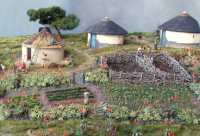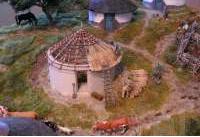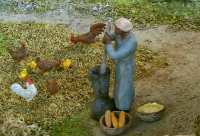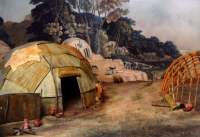1. ETHNIC RECONSTRUCTION MODEL – A XHOZA HOMESTEAD
(CATA, EASTERN CAPE / SOUTH ARICA)
(CATA, EASTERN CAPE / SOUTH ARICA)
Historic reconstruction model of a typical Xhosa homestead for small rural exhibition. The model depicts the rural lifestyle of plenty before the people were forcibly removed during apartheid from the area and had to return in poverty.
The particular challenging part of the model was the custom made aloe plants I had to make out of paper – all ± 13,500 leaves.
CONCEPT: The model is the central focus point of a small exhibition at Cata, a rural community museum.
CLIENT: Border Rural Committee (BRC) Eastern Cape.
MEDIA: Mixed: Styrene, paper, resin, etc.
SIZE: 120 cm x 80 cm
SCALE: 1:43
RESEARCHED AND CREATED: 2006
 |
| The Computer Aided Design (CAD) |
 |
| The final Model |
 |
| Detail #1 |
 |
| Inside a Hut |
 |
| Detail #3 |
 |
| Detail #2 |
2. ETHNIC RECONSTRUCTION MODEL – A KHOI-SAN HUT
The Khoi-San were a nomadic tribe at the tip of Southern Africa and their huts were cleverly constructed in order to move on, especially if they heard a certain bird’s ominous call.
The research on how these huts were constructed, utensils etc., was collated and interpreted by me to create this model. The construction of the lattice roof was executed exactly as was originally done and proved amazingly strong for its size.
CONCEPT: Study model in ethnic museum display.
CLIENT: Iziko Museums of Cape Town.
MEDIA: Mixed: Styrene, wallpaper, rattan (for hut lattice) etc.
SIZE: 120 cm x 90 cm
SCALE: 1:10
RESEARCHED AND CREATED: 1998
 |
| Inside a Hut |
© Peter Laponder 2006